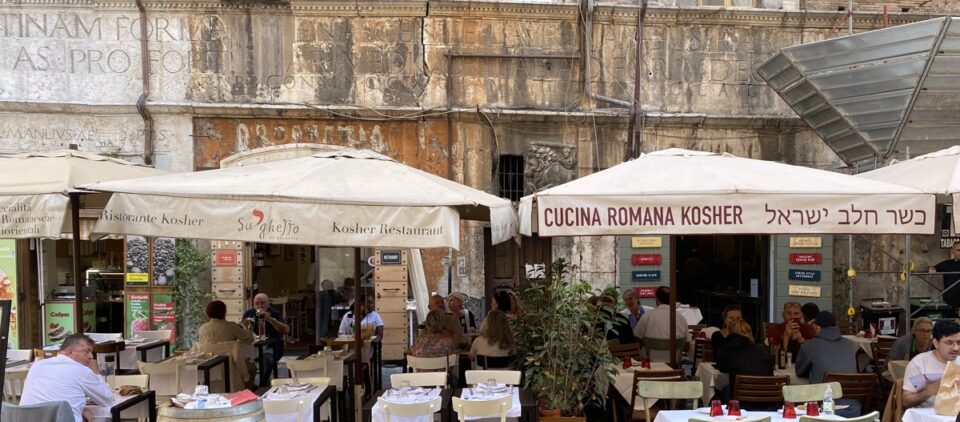Podcast: Play in new window | Download (Duration: 29:27 — 27.0MB)
Subscribe: Google Podcasts | Spotify | Android | RSS | More
 Today is the 80th anniversary of the roundup and deportation to Auschwitz of the Jews of Rome. That much I knew as I was planning this episode. More recent events took me and everyone else completely by surprise. I am sticking to my plan.
Today is the 80th anniversary of the roundup and deportation to Auschwitz of the Jews of Rome. That much I knew as I was planning this episode. More recent events took me and everyone else completely by surprise. I am sticking to my plan.
Rome’s former ghetto has become a tourist attraction, with an interesting museum under the Great Synagogue and plenty of other sites to see. And where there are tourists, there is food. The foodification of the ghetto, however, goes well beyond overpriced snacks. Both sides of the main street, the via del Portico Ottavia, are almost completely lined with restaurants. What I find most mysterious about this is that one of the most popular Roman foods, carciofi alla giudia, is freely available all over Rome and beyond. What makes this deep-fried delight Jewish? And how has food in the ghetto changed?
To help me understand the transformation of Rome’s Jewish foodscape I enlisted the help of Micaela Pavoncello, a member of the Jewish Community, and Sean Wyer, who has been studying the changes in the former ghetto.
Notes
- Micaela Pavoncello runs Jewish Roma Walking Tours and offers a wide range of tours and other activities.
- Sean Wyer’s paper Gourmet and the Ghetto: The “Foodification” of Rome’s Historic Jewish Quarter is available from his website.
- Finally, the transcript
- Cover photograph by seventyoneplace, used with permission. Other pictures by me.


Bridgy Response
@etp @dukepaaron
Yes, that’s the part part I’m taking issue with, since I knew all that going in.
I recognize your podcast is about food and not politics, but it’s precisely that issue which stood out like a neon sign to me.
Jews have been places for a long time, and yet our presence in a place is seen as “taking over” and “pushing out the native population”.
I don’t know about the UK, but we see this a lot in the US, and in Rome it’s even more glaringly racist because it’s this idea that the Jews, who have been there for 2,000 years, are suddenly “pushing out” the “natives” with their “ethnic cuisine”.
@serge Listen on. The Jews have been there for 100 years and lower down on the banks of the Tiber for centuries. So they’re not coming to the neighbourhood. It is their neighbourhood. Gentrification refers in this context to something slightly different.
@dukepaaron
Am still listening to the podcast, but already something struck me.
There’s a section on “Foodification” and talking about “Gentrification”.
This idea that Jews are “coming and ruining the neighborhood” is extremely common. While your podcast is a good podcast, since you mentioned that issue of gentrification, I thought it bore mentioning that this specific trope does not exist in isolation.
@etp @dukepaaron
@etp awesome! Looking forward to listening to it today.